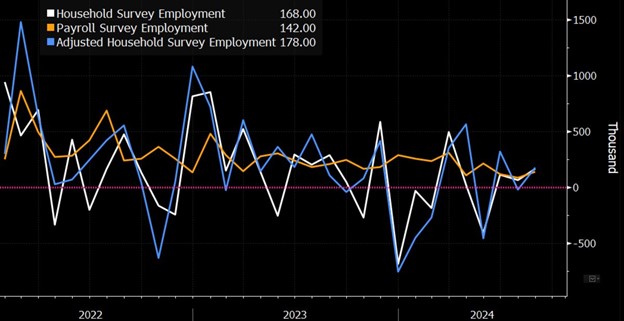Anna Wong, Stuart Paul, Eliza Winger, Estelle Ou
Bloomberg
September 6, 2024
OUR TAKE: August’s jobs report is a mixed one: The unemployment rate fell on a rounded basis, but headline nonfarm payroll gains disappointed. Moreover, the large downward revisions to prior data means that — adjusting for the BLS’s outdated factors for jobs created by business formations and closures — payrolls were likely negative in July.
On its own, this payroll report would argue for a 25-basis-point rate cut at the September FOMC meeting — it lacks the urgency that might convince some FOMC officials to opt for a larger cut. That said, the extremely downbeat Beige Book — one of Fed Chair Jerome Powell’s favorite indicators — and a string of other subpar labor-market data in the intermeeting period still support the case for a 50-bp move. Our takeaway is that odds now somewhat favor a 25-bp cut, but we can’t entirely take the larger move off the table.
- Nonfarm payrolls showed a net gain of 142k (vs. July’s downwardly revised 89k), lower than the consensus estimate of 165k but close to our estimated 145k. June payrolls were also revised down, to 118k from the previous toll of 206k.
- The household survey was stronger, with employment increasing 168k (vs. 67k prior). Adjusted to match nonfarm-payroll definitions — which means including holders of multiple jobs, and excluding employment in private households, among other things – August employment rose 178k (vs. -19k prior).
- The number of people who lost jobs in August declined by 162k (vs. +314k prior). Temporary layoffs declined by 190k, reversing most of the 249k increase from July. Non-temporary layoffs rose 29k (vs. 65k prior).
- The BLS’s “birth-death model” contributed a net 100k to August’s nonseasonally adjusted monthly job change of 263k. Considering the birth-death model and other factors, we think payroll prints in 2024 are likely overstating actual payrolls by an average of 91k per month. Adjusting for that, August payrolls probably rose just 51k in reality.
- The U-3 unemployment rate fell by 3 bps to 4.22% (vs. 4.25% prior). That matches the consensus expectation of 4.2%, but is lower than our forecast of 4.3%.
- The tick down in the unemployment rate was mostly due to more people finding jobs. The labor force expanded by 120k people, while employment rose by 168k.
- Foreign-born workers appear to account for much of the change in unemployment. The nonseasonally adjusted unemployment rate for foreign-born workers fell from 4.7% in July to 4.3% in August. Native workers’ jobless rate fell from 4.5% to 4.4%.
- Average hourly earnings increased 0.4% during the month, up from 0.2% in July and exceeding the consensus estimate of 0.3%.
- Average weekly hours worked increased modestly to 34.3 from 34.2 prior. When viewed in tandem with wages, average weekly earnings increased nearly 0.7% in August.
- Bottom line: August’s jobs report provided a mixed picture of the labor market. The slight improvement in the unemployment rate suggests things have improved, but large downward revisions to July data and the disappointing NFP print — even when adjusted for the estimated overstatement — means jobs creation was probably flat in July, and barely positive in August. Powell may not be able to convince other Fed officials to vote for jumbo rate cut after this print.
Employment Rebounds Slightly, But Trend Is Slowing

Source: BLS, Bloomberg Economics
